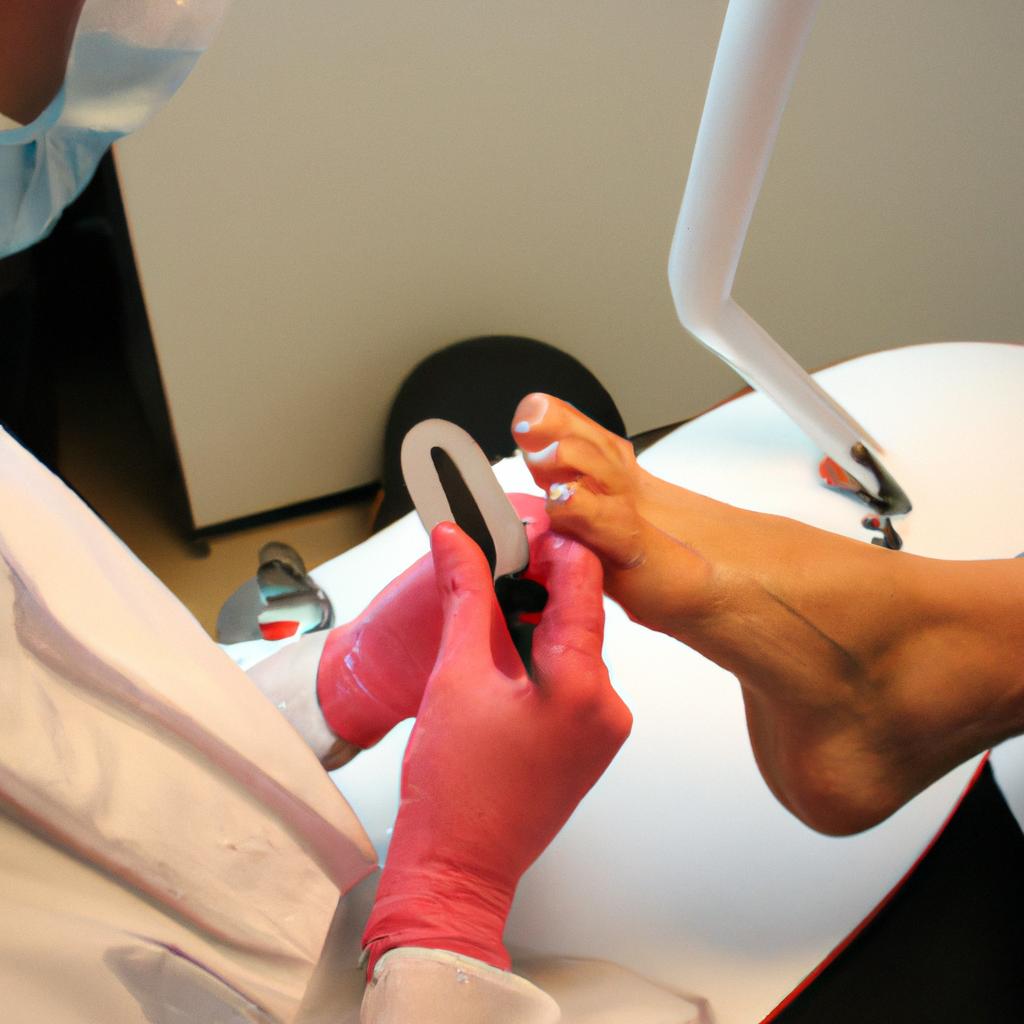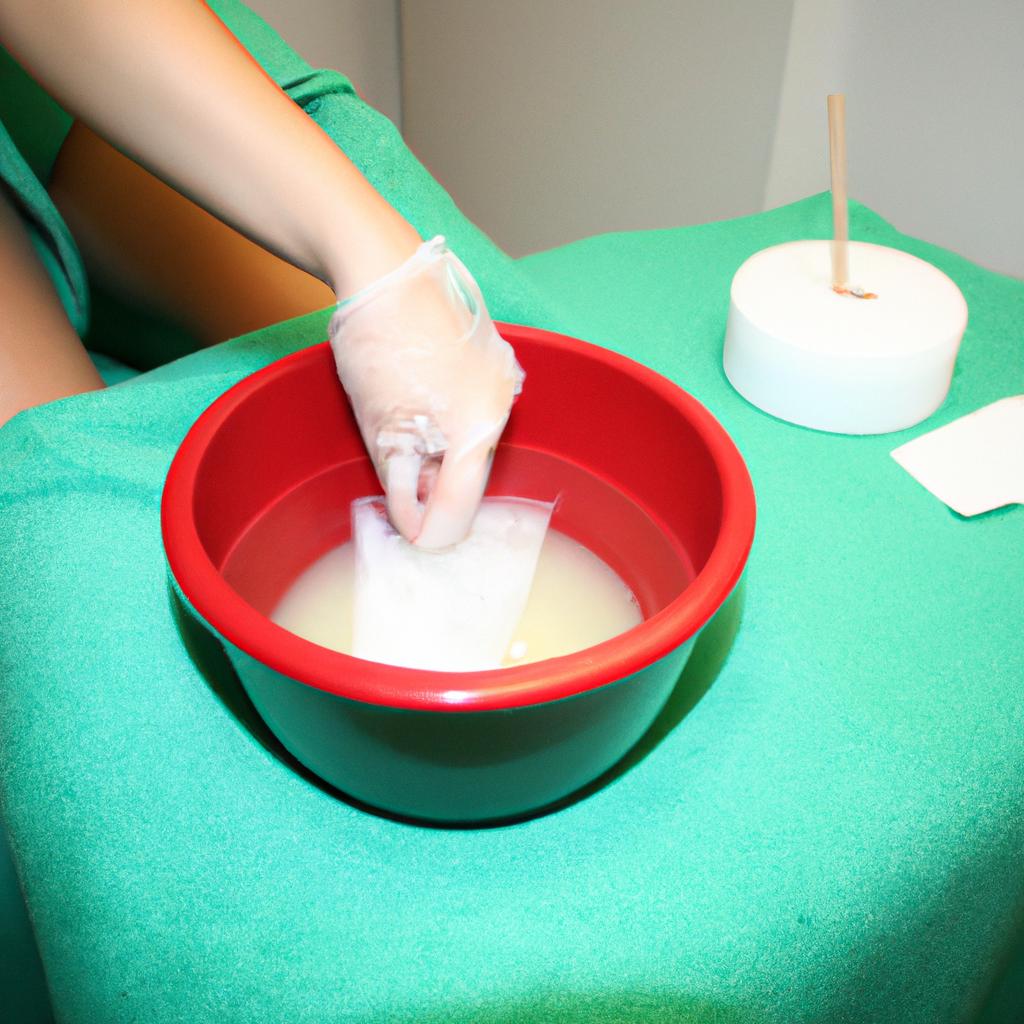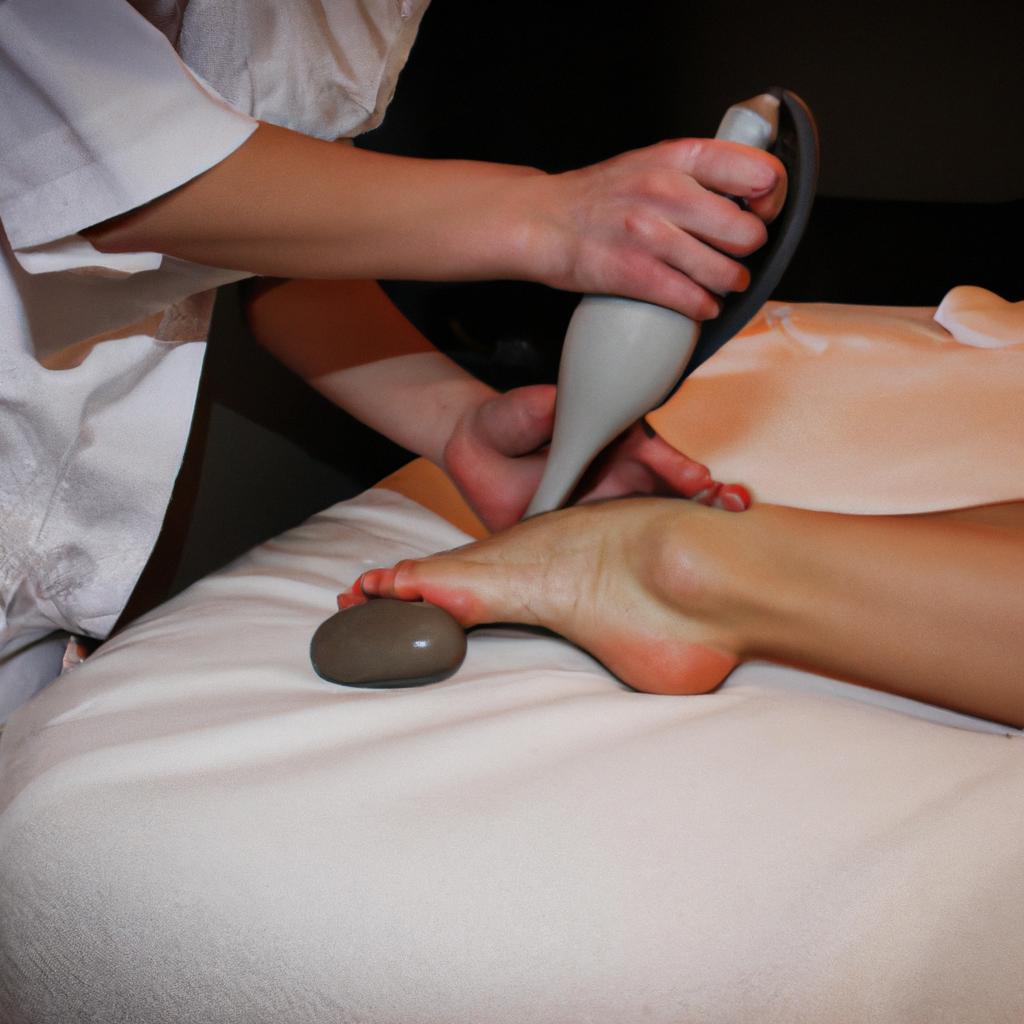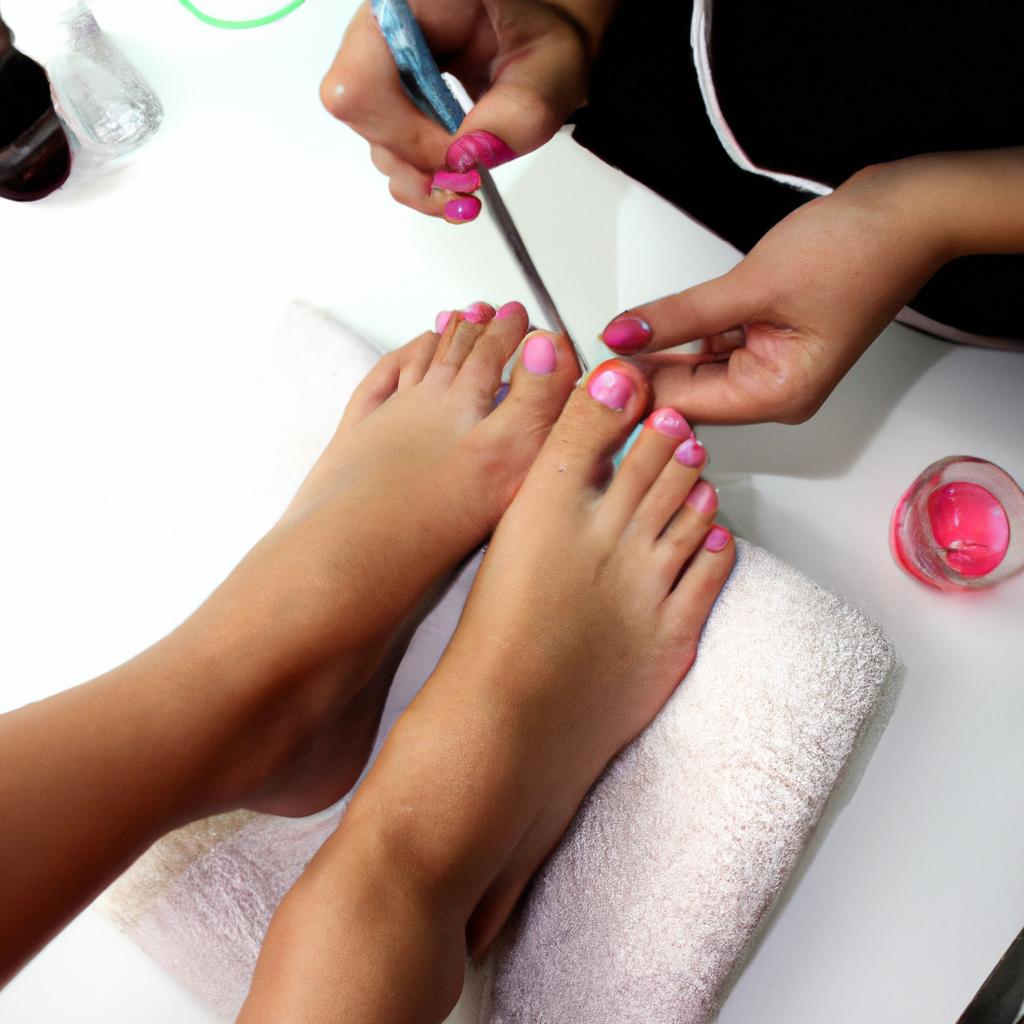Callus removal is a common procedure performed during day spa pedicures to improve the appearance and comfort of clients’ feet. Whether it be from wearing ill-fitting shoes or walking long distances, calluses can develop on various parts of the foot, causing pain and discomfort. In order to provide an effective treatment for this condition, estheticians must possess knowledge about different techniques and tools used in callus removal. This article aims to serve as an informative guide, discussing the importance of callus removal in day spa pedicures and providing insights into the most commonly employed methods.
Imagine a scenario where a client enters a day spa seeking relief from painful calluses that have been bothering them for weeks. They are eager to find a solution that not only addresses their immediate discomfort but also promotes healthier skin on their feet. This case study exemplifies the significance of callus removal within the context of day spa pedicures. By understanding how calluses form and learning about proper techniques for their removal, estheticians can offer effective treatments tailored to each individual’s needs, ultimately enhancing both physical well-being and overall customer satisfaction.
In this comprehensive guide, we will explore various aspects related to callus removal in day spa pedicures. We will delve into topics such as the causes of callus formation, the importance of proper technique and tools in callus removal, and different methods used to effectively remove calluses. Additionally, we will discuss post-removal care and prevention strategies to help clients maintain healthy feet in the long term.
Understanding the causes of callus formation is crucial for estheticians to provide targeted treatment. We will explore factors such as repetitive friction or pressure on specific areas of the feet, ill-fitting footwear, and certain medical conditions that can contribute to callus development. By identifying these underlying causes, estheticians can address them during the treatment process and offer recommendations for preventing future callus formation.
Proper technique and tools play a significant role in effective callus removal. Estheticians must be knowledgeable about different tools used in this procedure, such as foot files, pumice stones, or electric callus removers. Each tool has its own advantages and limitations, and estheticians should be able to assess which tool is best suited for each client’s needs. Furthermore, understanding how to safely use these tools without causing harm or discomfort is essential for providing a positive experience for clients.
We will also discuss various methods employed in day spa pedicures for removing calluses. This may include manual exfoliation using foot files or pumice stones, chemical exfoliation with products containing ingredients like alpha hydroxy acids (AHAs), or mechanical exfoliation using electric callus removers. Estheticians need to have a comprehensive understanding of these methods and their respective benefits to tailor treatments according to individual preferences and requirements.
Post-removal care is equally important as the actual removal process itself. We will outline strategies for moisturizing and nourishing the skin after callus removal to promote healing and prevent further dryness or cracking. Additionally, we will provide guidance on preventive measures clients can take at home between appointments to maintain healthy feet and minimize the recurrence of calluses.
In conclusion, this comprehensive guide will serve as a valuable resource for estheticians and clients alike, offering insights into the importance of callus removal in day spa pedicures. By understanding the causes of callus formation, employing proper technique and tools, and utilizing effective methods, estheticians can provide optimal results and enhance client satisfaction.
What is a callus?
A callus is a thickened area of skin that forms in response to repeated pressure or friction. It serves as the body’s natural defense mechanism, providing protection to underlying tissues from harm. Imagine a dedicated runner who trains for hours each day. Over time, they may develop calluses on their feet due to the constant rubbing and pressure exerted during running.
To better understand calluses, let’s explore some key characteristics:
Callus Characteristics
- Texture: Calluses typically have a tough and rough texture, often resembling hardened or thickened skin.
- Appearance: They can appear yellowish or pale in color compared to the surrounding healthy skin.
- Location: Common areas prone to developing calluses include the soles of the feet, heels, toes, and palms of the hands.
- Discomfort: While calluses are generally painless, they can cause discomfort when subjected to excessive pressure or irritation.
Understanding these features helps professionals identify and address calluses effectively during spa pedicures. Now let’s delve into why it is crucial to prioritize callus removal.
Why is callus removal important? In order to maintain healthy feet and provide optimal care during pedicures, it is essential to remove calluses properly by addressing both aesthetic concerns and potential discomfort experienced by clients.
Why is callus removal important?
Callus Removal for Day Spa Pedicures: A Informative Guide
…
…
Now, let’s explore the importance of callus removal in more detail. Picture this scenario: Emily, a hardworking nurse who spends long hours on her feet, recently noticed that she has developed thick and hardened skin on the soles of her feet. This condition not only affects the appearance of her feet but also causes discomfort and pain while walking or standing for extended periods. Calluses can form due to various reasons such as friction, pressure, or repetitive movements.
To understand why callus removal is crucial, consider these key points:
- Pain relief: Calluses can be painful and uncomfortable. Removing them helps alleviate any associated pain.
- Improved foot health: By removing calluses, you enhance overall foot health and reduce the risk of developing other foot conditions.
- Enhanced aesthetics: Regularly removing calluses ensures smoother and softer feet, making them visually appealing.
- Increased comfort: Eliminating calluses provides a more comfortable walking experience by reducing pressure areas.
Consider the following table showcasing different methods used for callus removal:
| Method | Pros | Cons |
|---|---|---|
| Pumice stone | Affordable | Time-consuming |
| Foot files | Quick results | Requires caution |
| Chemical peels | Effective | May cause irritation |
| Electric callus removers | Fast and efficient | Expensive equipment |
In summary, addressing calluses through proper removal techniques not only offers pain relief but also improves foot health and enhances aesthetic appeal. By considering different approaches outlined above — from pumice stones to electric callus removers — individuals can choose a method that suits their preferences and needs.
Next, we will delve into exploring various methods for effective callus removal.
Different methods for callus removal
Understanding the significance of callus removal, let us now explore various techniques used in day spa pedicures to effectively eliminate calluses. To illustrate this, consider the case of Sarah, a regular client at our day spa who often struggles with thickened skin on her heels and soles. By implementing different methods tailored to each individual’s needs, we can ensure efficient and satisfying results.
Different Methods for Callus Removal:
-
Manual Exfoliation:
- Utilizing a pumice stone or foot file, estheticians gently remove dead skin cells and reduce calluses.
- This method allows therapists to precisely target problem areas while providing control over pressure applied.
-
Chemical Solutions:
- Certain solutions contain active ingredients like salicylic acid or urea that soften hardened skin.
- These substances work by breaking down keratin protein bonds within the callused area, making it easier to slough off dead skin.
-
Mechanical Devices:
- Electric files equipped with varying grits of sanding discs are commonly used in professional settings.
- These devices offer controlled abrasion and allow therapists to efficiently remove layers of toughened skin without causing discomfort.
Emotional Bullet Point List (Markdown format):
- Enhanced comfort and improved overall appearance
- Increased confidence when wearing open-toed shoes
- Improved foot hygiene leading to reduced chances of infections
- Enhanced relaxation through smoother feet during massage therapies
Emotional Table (Markdown format):
| Benefits | Examples |
|---|---|
| Softened Skin | Silky smooth texture |
| Reduced Discomfort | Eliminated roughness |
| Improved Aesthetics | Visibly appealing |
| Enhanced Relaxation | Unwinding experience |
By employing these different methods, therapists are able to provide tailored solutions for callus removal during day spa pedicures. However, professional callus removal tools can further optimize the process and deliver exceptional results. Let us now explore some of these specialized tools in detail, ensuring a comprehensive understanding of their benefits and applications.
Professional callus removal tools
Different methods for callus removal have been employed in the field of pedicures to ensure smooth and rejuvenated feet. In this section, we explore some professional tools that are commonly used by day spas to effectively remove calluses.
One popular tool is the electric callus remover, which operates using a rotating abrasive disc or roller head. This device gently buffs away layers of dead skin cells, revealing softer and smoother skin underneath. The speed and intensity of the rotary motion can be adjusted according to the client’s comfort level and the severity of their calluses. For instance, consider a hypothetical case where a client arrives at a day spa with thick calluses on their heels. By utilizing an electric callus remover, the esthetician can efficiently reduce those calluses without causing discomfort.
Another method utilized in day spas is manual callus removal through the use of specialized metal implements such as foot files or pumice stones. These tools allow therapists to manually exfoliate rough areas on clients’ feet and achieve desired results. Here are four benefits associated with manual callus removal:
- Precise control over pressure applied: Manual techniques offer flexibility in determining how much pressure should be exerted during treatment.
- Ability to target specific areas: Therapists can focus on particular problem spots rather than treating the entire foot uniformly.
- Suitable for sensitive skin: Some individuals may have skin conditions or sensitivities that make them unsuitable candidates for electric devices.
- Cost-effective option: Manual tools typically require lower initial investment compared to electric devices.
To provide a comprehensive overview, let us examine a comparison between these two methods using a table:
| Aspect | Electric Callus Remover | Manual Callus Removal |
|---|---|---|
| Comfort | Adjustable settings | Dependent on technique |
| Efficiency | Quick results | Time-consuming |
| Suitability for all | May not suit sensitive | Suitable for all |
| skin types | skin types | skin types |
In summary, day spas employ various professional tools to address callus removal during pedicures. Electric callus removers offer quick and efficient results while manual methods provide therapists with more control over the process. Ultimately, choosing the appropriate technique depends on factors such as client preferences, comfort level, and the severity of their calluses.
Moving forward, it is essential to consider safety precautions when performing callus removal procedures in a day spa setting.
Safety precautions for callus removal
Professional Callus Removal Tools
In the previous section, we explored the various tools that professionals use for callus removal during day spa pedicures. Now, let’s delve into some important safety precautions to ensure a safe and effective callus removal process.
Safety Precautions for Callus Removal
To illustrate the significance of these safety precautions, let’s consider an example: imagine a client with severe calluses on their feet comes in for a pedicure. The esthetician begins the callus removal procedure without taking necessary precautions. As a result, they accidentally cause a small cut on the client’s foot, leading to potential infection or further complications. This situation emphasizes why it is essential to follow proper safety guidelines when performing callus removal techniques.
To guarantee both client satisfaction and overall well-being, here are some key safety precautions to keep in mind:
-
Proper sterilization: Ensure all tools used for callus removal are thoroughly cleaned and disinfected before each use. This prevents cross-contamination between clients and minimizes the risk of infections.
-
Gentle pressure: Apply gentle pressure while using professional callus removal instruments to avoid causing discomfort or injury to the skin underneath. Remember that excessive force can lead to pain or damage.
-
Avoid overexfoliation: It is crucial not to remove too much dead skin during one session as this may leave the underlying skin vulnerable and prone to irritation or redness.
-
Regular maintenance: Routinely inspect your callus removal tools for any signs of wear or damage. Replace them promptly if needed to maintain effectiveness and reduce the risk of accidents.
By adhering to these safety measures, you can provide a secure environment for your clients throughout the callus removal process.
Tips for Maintaining Callus-Free Feet
Now that we have discussed professional callus removal tools and safety precautions, let’s explore some valuable tips for maintaining smooth and healthy feet at home.
Tips for maintaining callus-free feet
Section Title: Maintaining Callus-Free Feet: Essential Tips for Long-Term Care
Transitioning from ensuring safety during callus removal, it is equally crucial to provide clients with the necessary information on maintaining callus-free feet. By incorporating these tips into their daily routines, individuals can achieve long-term care and prevent the recurrence of calluses.
To illustrate the significance of these maintenance practices, let us consider a hypothetical case study. Meet Sarah, an avid runner who frequently experiences calluses on her feet due to intense training sessions. Despite regular visits to the day spa for professional pedicures, Sarah finds that her calluses often return shortly after treatment. However, by implementing the following tips into her routine, she can effectively manage and maintain smooth and healthy feet:
-
Moisturize Daily:
- Apply a rich foot cream or lotion containing ingredients such as urea or lactic acid.
- Massage the moisturizer onto clean, dry feet before bed to allow maximum absorption.
- Wear breathable socks made from natural fibers like cotton to retain moisture while preventing excessive sweat buildup.
-
Exfoliate Regularly:
- Use a gentle foot scrub or pumice stone in circular motions to remove dead skin cells.
- Focus on areas prone to callusing, such as heels and balls of the feet.
- Perform exfoliation once or twice per week during bath or shower time for optimal results.
-
Proper Footwear Selection:
- Invest in well-fitting shoes that offer adequate support and cushioning.
- Avoid tight footwear that may cause friction and pressure points leading to callus formation.
- Opt for open-toed shoes when appropriate, allowing air circulation around the feet.
-
Maintain Healthy Hygiene Habits:
- Keep toenails trimmed regularly but avoid cutting them too short.
- Cleanse your feet thoroughly with mild soap and warm water daily.
- Dry feet completely, particularly between the toes, to prevent fungal infections.
To further emphasize these tips, consider the following table showcasing the potential benefits of implementing each practice:
| Practice | Benefits |
|---|---|
| Daily Moisturizing | Hydrates and softens skin |
| Regular Exfoliation | Removes dead skin cells |
| Proper Footwear | Reduces friction and pressure points |
| Healthy Hygiene Habits | Maintains cleanliness and prevents infections |
By incorporating these practices into their daily routine, clients like Sarah can enjoy long-lasting results from callus removal treatments. With consistent care and attention to foot health, individuals can achieve smooth and callus-free feet for an extended period.
Incorporating these maintenance techniques will not only extend the efficacy of professional pedicures but also empower clients to take control of their foot health. By adopting a proactive approach towards self-care, individuals can ensure that their feet remain healthy, comfortable, and free from unsightly calluses.




